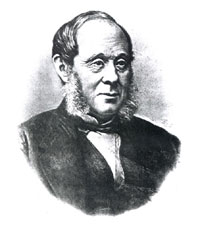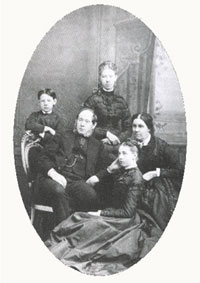
Bech Family History
 Edward
Bech was born May 4, 1812 in Denmark. His father, Jorgen, a friend of
Crown Prince Frederik, was a successful merchant. Edward was educated
at the University of Copenhagen and later went to the Hanseatic city of
Lubeck for a commercial education. He arrived in New York in 1838. After
working for others he formed his own trading firm in 1842 which continued
for 47 years until the death of his son George. Also in 1838 he became
the Danish Consul in New York, a position that he held until 1858. He
was knighted by the Danish king on Oct. 5, 1854.
Edward
Bech was born May 4, 1812 in Denmark. His father, Jorgen, a friend of
Crown Prince Frederik, was a successful merchant. Edward was educated
at the University of Copenhagen and later went to the Hanseatic city of
Lubeck for a commercial education. He arrived in New York in 1838. After
working for others he formed his own trading firm in 1842 which continued
for 47 years until the death of his son George. Also in 1838 he became
the Danish Consul in New York, a position that he held until 1858. He
was knighted by the Danish king on Oct. 5, 1854.
In addition to his own funds he inherited large sums of money from his father. He moved to Poughkeepsie in 1851 and lived at 57 Market St. Poughkeepise for about 10 years. He became involved with the "pig iron" trade and started the Tuckerman and Bech Iron Company, a thriving riverfront industry that prospered with the advent of the Delaware and Hudson Canal and Railroad. He was also a partner in the Cunard Steamship Company.
In 1863, Bech purchased Hickory
Grove, a 65 acre farm along the Hudson River which he named "Rosenlund."
He hired Detlef Lienau, a prominent architect and fellow countryman, to
design the estate. The "Hickory Grove" main house was still
useable so Lienau drew up the plans for a mansion, barn, carriage house
and gatehouse. The service  buildings
had been constructed when Bech died in 1873 terminating the project. The
mansion was never built, but the drawings, displayed in the architectural
drawing section of this web site, are part of the Avery Collection at
Columbia University. At his death Edward Beck left an estate valued at
$1,837,342. His son George continued managing his businesses until his
death in 1890. His widow kept Rosenlund until her death in 1900. In 1908
the property was sold to the Marist Brothers who later founded Marist
College.
buildings
had been constructed when Bech died in 1873 terminating the project. The
mansion was never built, but the drawings, displayed in the architectural
drawing section of this web site, are part of the Avery Collection at
Columbia University. At his death Edward Beck left an estate valued at
$1,837,342. His son George continued managing his businesses until his
death in 1890. His widow kept Rosenlund until her death in 1900. In 1908
the property was sold to the Marist Brothers who later founded Marist
College.
The three service buildings now known as Greystone, St. Peter's and the Kieran Gate House were listed on the National Register of Historic Places in 1991.
Edward Bech's contribution was his vision of building up the iron industry in the city of Poughkeepsie. He saw Poughkeepsie as the center, the hub of a four spoked industry with coal coming in from the West, iron ore from the North, both economically transported via water, with the processing done in New York, Brooklyn, New England and Boston. It was to accomplish this dream that a great railroad bridge was built in Poughkeepsie. This bridge continued in use until 1974 when a fire damaged it so badly that it was never regularly used again.
